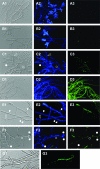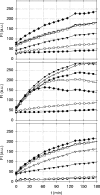Studies on the mode of action of the antifungal hexapeptide PAF26
- PMID: 17065623
- PMCID: PMC1635192
- DOI: 10.1128/AAC.00650-06
Studies on the mode of action of the antifungal hexapeptide PAF26
Abstract
The small antimicrobial peptide PAF26 (Ac-RKKWFW-NH(2)) has been identified by a combinatorial approach and shows preferential activity toward filamentous fungi. In this work, we investigated the mode of action and inhibitory effects of PAF26 on the fungus Penicillium digitatum. The dye Sytox Green was used to demonstrate that PAF26 induced cell permeation. However, microscopic observations showed that sub-MIC concentrations of PAF26 produced both alterations of hyphal morphology (such as altered polar growth and branching) and chitin deposition in areas of no detectable permeation. Analysis of dose-response curves of inhibition and permeation suggested that growth inhibition is not solely a consequence of permeation. In order to shed light on the mode of PAF26 action, its antifungal properties were compared with those of melittin, a well-known pore-forming peptide that kills through cytolysis. While the 50% inhibitory concentrations and MICs of the two peptides against P. digitatum mycelium were comparable, they differed markedly in their fungicidal activities toward conidia and their hemolytic activities toward human red blood cells. Kinetic studies showed that melittin quickly induced Penicillium cell permeation, while PAF26-induced Sytox Green uptake was significantly slower and less efficient. Therefore, the ultimate growth inhibition and morphological alterations induced by PAF26 for P. digitatum are not likely a result of conventional pore formation. Fluorescently labeled PAF26 was used to demonstrate its specific in vivo interaction and translocation inside germ tubes and hyphal cells, at concentrations as low as 0.3 muM (20 times below the MIC), at which no inhibitory, morphological, or permeation effects were observed. Interestingly, internalized PAF26 could bind to cellular RNAs, since in vitro nonspecific RNA binding activity of PAF26 was demonstrated by electrophoretic mobility shift assays. We propose that PAF26 is a short, de novo-designed penetratin-type peptide that has multiple detrimental effects on target fungi, which ultimately result in permeation and killing.
Figures







Similar articles
-
Concentration-dependent mechanisms of cell penetration and killing by the de novo designed antifungal hexapeptide PAF26.Mol Microbiol. 2012 Jul;85(1):89-106. doi: 10.1111/j.1365-2958.2012.08091.x. Epub 2012 May 31. Mol Microbiol. 2012. PMID: 22646057
-
Identification of novel hexapeptides bioactive against phytopathogenic fungi through screening of a synthetic peptide combinatorial library.Appl Environ Microbiol. 2002 May;68(5):2453-60. doi: 10.1128/AEM.68.5.2453-2460.2002. Appl Environ Microbiol. 2002. PMID: 11976121 Free PMC article.
-
Two functional motifs define the interaction, internalization and toxicity of the cell-penetrating antifungal peptide PAF26 on fungal cells.PLoS One. 2013;8(1):e54813. doi: 10.1371/journal.pone.0054813. Epub 2013 Jan 21. PLoS One. 2013. PMID: 23349973 Free PMC article.
-
Antimicrobial properties of derivatives of the cationic tryptophan-rich hexapeptide PAF26.Biochem Biophys Res Commun. 2007 Mar 2;354(1):172-7. doi: 10.1016/j.bbrc.2006.12.173. Epub 2007 Jan 12. Biochem Biophys Res Commun. 2007. PMID: 17222805
-
Concatemerization increases the inhibitory activity of short, cell-penetrating, cationic and tryptophan-rich antifungal peptides.Appl Microbiol Biotechnol. 2015 Oct;99(19):8011-21. doi: 10.1007/s00253-015-6541-1. Epub 2015 Apr 7. Appl Microbiol Biotechnol. 2015. PMID: 25846331
Cited by
-
Control of Citrus Post-harvest Green Molds, Blue Molds, and Sour Rot by the Cecropin A-Melittin Hybrid Peptide BP21.Front Microbiol. 2018 Oct 10;9:2455. doi: 10.3389/fmicb.2018.02455. eCollection 2018. Front Microbiol. 2018. PMID: 30364142 Free PMC article.
-
Mechanisms of action for 2-phenylethanol isolated from Kloeckera apiculata in control of Penicillium molds of citrus fruits.BMC Microbiol. 2014 Sep 19;14:242. doi: 10.1186/s12866-014-0242-2. BMC Microbiol. 2014. PMID: 25230758 Free PMC article.
-
Deciphering the mode of action of a mutant Allium sativum Leaf Agglutinin (mASAL), a potent antifungal protein on Rhizoctonia solani.BMC Microbiol. 2015 Oct 26;15:237. doi: 10.1186/s12866-015-0549-7. BMC Microbiol. 2015. PMID: 26502719 Free PMC article.
-
The Penicillium digitatum protein O-mannosyltransferase Pmt2 is required for cell wall integrity, conidiogenesis, virulence and sensitivity to the antifungal peptide PAF26.Mol Plant Pathol. 2015 Sep;16(7):748-61. doi: 10.1111/mpp.12232. Epub 2015 Feb 4. Mol Plant Pathol. 2015. PMID: 25640475 Free PMC article.
-
Peptide-based Antifungal Therapies against Emerging Infections.Drugs Future. 2010 Mar;35(3):197. doi: 10.1358/dof.2010.035.03.1452077. Drugs Future. 2010. PMID: 20495663 Free PMC article.
References
-
- Broekaert, W. F., F. R. G. Terras, B. P. A. Cammue, and J. Vanderleyden. 1990. An automated quantitative assay for fungal growth-inhibition. FEMS Microbiol. Lett. 69:55-59.
-
- Brogden, K. A. 2005. Antimicrobial peptides: pore formers or metabolic inhibitors in bacteria? Nat. Rev. Microbiol. 3:238-250. - PubMed
-
- Epand, R. M., and H. J. Vogel. 1999. Diversity of antimicrobial peptides and their mechanisms of action. Biochim. Biophys. Acta 1462:11-28. - PubMed
-
- Gonzalez, C. F., E. M. Provin, L. Zhu, and D. J. Ebbole. 2002. Independent and synergistic activity of synthetic peptides against thiabendazole-resistant Fusarium sambucinum. Phytopathology 92:917-924. - PubMed
Publication types
MeSH terms
Substances
LinkOut - more resources
Full Text Sources
Medical

